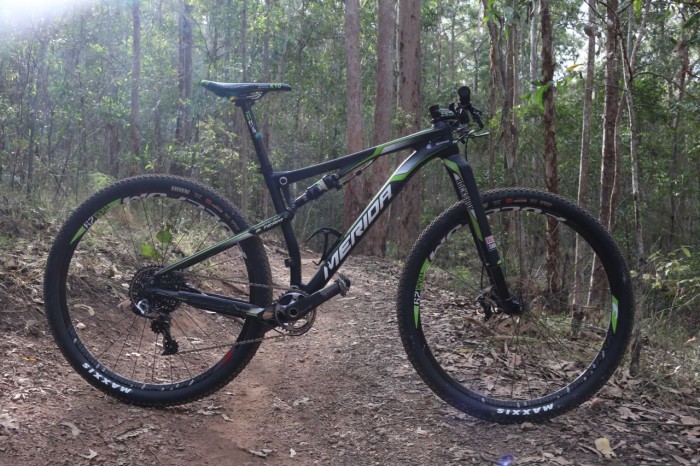With offices in Germany, and an uber-strong mountain bike race team starring riders like Gunn-Rita Dahle Flesjå and José Hermida, you’d be forgiven for assuming that Merida was as Euro as Nutella and headbands. Not so. Merida was founded in the early 70s by Taiwanese engineer Ike Tseng who, it is rumoured, was so incensed when he saw a sign in a US bike shop refusing to service Asian-made bikes, decided to found a brand with design, manufacture, and sales all based in Taiwan. A brand that would prove that high-quality machines could be manufactured in Asia and succeed around the world.
The 2016 Merida Ninety-Six Team could well realise this ambition once and for all. It’s being promoted as the ‘rebirth of a legend’, the original version being first sold in Europe in 2007 as a high-end 26” bike named for its 96mm of rear travel. The bike has since been on a bumpy evolutionary track, morphing into a marathon-specific 29er in 2012, then disappearing for a while before resurfacing this year for a show-stopping reveal: sleeker, lighter, and faster than ever before.
With lots of input from the Multivan-Merida team riders, the Ninety Six is about an aggressive an XCO race dually as you can get. With the super-stiff RockShox RS-1 fork, a shorter top tube and tighter wheel base than previous models, the bike’s main purpose is to deliver agility to technically demanding XCO tracks, particularly as they demand more and more from riders’ bike handling skills.
Here’s José Hermida, complete with Euro headband, talking about his Merida Ninety Six on the World Cup circuit.
https://youtu.be/V_h1hgtOMu4
The bike has a bunch of smart, sleek, and well-designed extras that are a true sign of the times, like a removable front derailleur mount and ‘Smart Entry’ technology for tidy, easy internal cable routing with Di2 and dropper post options (and indeed it’s likely we’ll see some of the Multivan-Merida pros trialling droppers in a World Cup sometime soon).
The Smart Entry cable management system.
We’ve already discussed the suspension technology and frame ‘size specific wheeling’ in our first look at this machine earlier this year… so, what’s it like to ride?
First of all, the bike is incredibly stiff, particularly in the front end, owing a good deal to the RS-1 fork, and to the premium carbon fibre used in its manufacture, which you can learn more about in the video below.
The Ninety Six is also a truly sharp handler, with a steep head angle and neat back end that whipped through corners more tidily than any short-travel 29” dually I’ve ridden to date. The geometry and set-up is aggressive, low, and the medium-sized bike I tested came with a fairly short stem with negative rise that accentuated the steering responsiveness. While these kinds of things can easily be changed, the out-of-the-box set-up definitely reflected the intended use of the bike.
The RS-1 helps with direct steering.
The bike’s as light and as highly-specced as any machine with a price tag like this should be (the exact price is yet to be released, but likely to be close to five figures) with a SRAM XX1 drivetrain and Guide RSC brakes. At the same time, smart extras like 180mm front rotor and hardy but race-worthy tyre choice of 2.2” Maxxis Ikons demonstrate that the team at Merida haven’t skimped on the necessary gear to tackle today’s XC circuit just to keep the weight down.
Guide RSC brakes keep it all in check.
Over small bumps the RS-1 is incredibly good, and the rear shock handles them rather well, but felt a bit stiff at first. This is down to the rear suspension’s ‘progressive leverage ratio that offers good support under pedalling, with the fuller range of the suspension travel designed to come into force under big hits. The double remote lockout is intelligently mounted on the left-hand side of the bars and, rather than offering complete rigidity, firms up the compression settings to provide movement if needed – a good option on long climbs.
The hanging link has been designed to optimise the suspension path.
XX1 – what’s not to like?
The RockShox lock out under the left side of the handlebar is one of the easiest to use on the market.
Sounds like a good team to be on.
The verdict? Every line, every curve, and every feature of this bike is designed to tackle demanding cross country courses. It’s an aggressive, agile machine with good efficiency and race pedigree. If you’re a pure marathon or marathon stage racer, you might opt for a bike with slightly more relaxed geometry to see you through long days on the bike… But it’s worth considering that, across most of the world, marathon events often incorporate tricky techy sections and vast kilometres of singletrack. If you love getting low and aggressive, this bike is well worth a look. Visit the Merida website for more.

